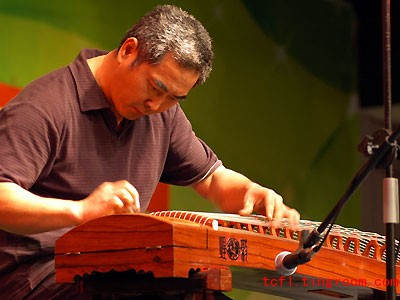Guqin is also known as the Seven-stringed Qin. The body is a long and narrow wooden sound box. Usually, it is 130 centimeters long, 20 centimeters wide and 5 centimeters high. The surface is generally made of paulownia wood or China fir, and has seven strings stretched along it. On the edges are 13 inlaid jade markers. Catalpa wood is used for the base, and there are two holes, one big and one small, which are named the ‘phoenix pool' and ‘dragon pond', to emit the sound.

The fingering skills are known as recital, rubbing, plucking, concentration, floating notes and harmonious notes. The instrument is rich in tone color with airy and floating notes, which can be called the sound of harmony. The most unique part of the Guqin probably lies in its performance etiquette. Before giving a performance, players should take a shower and burn incense in the room. They are to keep their minds peaceful and concentrated to ward off evil spirits.
- Musical culture in Guqin
The melodies of Guqin are gentle, pure and free from vulgarity, which echo with the Zheng (uprightness) of Confucianism, the Qing (softness) of Taoism, and He (harmony) of Buddhism. So, the Guqin is a representative instrument of traditional Chinese musical culture. The most famous Guqin repertoire is the High Mount and Flowing Water, which is also a metaphor for friends who can communicate their spiritual pursuits.
- A story of Guqin




